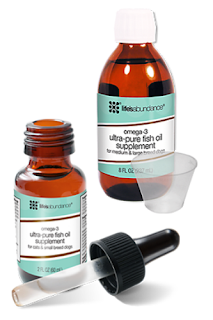Courtesy of Life's Abundance from the April 2018 Newsletter:
Lessons for Heartworm Awareness Month
April is National Heartworm Awareness Month, so I wanted to give everyone both a refresher and an update on this disease. Heartworms are transmitted via mosquito bites, meaning it is not transmissible directly from pet to pet. The tiny larvae are injected into the bloodstream, where they mature into fully grown adults. They live in the heart and large blood vessels. The mature worms produce larvae, which go back into circulation and can be picked up by mosquitoes, ready to transmit to another host, thus repeating a vicious cycle.
While dogs make for ideal hosts, cats can also be infected. However, canines experience the most severe form of the disease. If you are unsure whether your cat should be on heartworm prevention, speak with your veterinarian.
As you can imagine, foreign bodies the size of spaghetti strands can do a lot of damage in the heart. As the parasites disrupt normal heart and lung function, pets display signs of heart disease such as cough, low energy and coffee-colored urine. Treatment involves either surgery to physically remove the worms or injections of a drug called immiticide. Once a heartworm dies it can cause an embolus (a blockage) as it travels through the bloodstream, so patients are under strict cage rest to minimize treatment risks.
Bottom line, heartworm disease is a terrible thing and no one wants their companion animal to experience it.
Here’s the good news … it’s completely preventable. Once the mosquito injects the larva into the bloodstream, it takes six months for them to mature into adult heartworms. During that time the larvae are susceptible to a variety of medications. Heartworm prevention is available in a number of forms: pills, injections and topicals. They are all prescription medications, so your veterinarian can advise you as to which choice is best for your dog or cat.
If you have a dog or a cat, here are five important things you need to know about heartworm disease.
1. While heartworm disease is indeed more prevalent in the Atlantic and Gulf states, it has been diagnosed in all 50 states! Even if you live in a state with low incidences of the disease, all states have microclimates where heartworm flourishes. The American Heartworm Society tracks diagnosis information and publishes an incident map every three years. To see how many cases have been reported in your area, visit https://www.heartwormsociety.org/veterinary-resources/incidence-maps.
2. Dogs travel more than ever before. 2005 was a turning point in prevalence of the disease. Why? After Hurricane Katrina devastated the Gulf states, humane organizations rallied together to relocate homeless animals across the nation. Some of those dogs carried heartworm disease. Suddenly veterinarians who had never seen heartworm disease in their careers were diagnosing it for the first time.
3. All-natural remedies simply don’t work. I think by now you all know by know how much I value honesty and transparency. If you want to treat your pet for fleas with natural remedies, I will let you know that they simply don’t work as well as the medications I recommend, but I’m not going to fight you on it. Fleas don’t kill dogs and cats, though. Heartworm does. It is simply too devastating a disease to trust anything but the prescription medications that we know work. Anyone who claims otherwise is, in my opinion, displaying their ignorance and spreading poor advice.
4. Pets need monthly prevention to be adequately protected. A very common question is, "why do I need to give my pet monthly heartworm prevention pills if it takes six months for a larva to turn into an adult heartworm?" As the larva develops into an adult, it transitions through several phases. Not all of those phases are susceptible to our heartworm preventives. If we only dose heartworm prevention intermittently, there’s a chance we will miss our window for catching the larva at the susceptible stage.
5. Pets should be tested yearly. Yes, even pets on regular heartworm preventive. Why? Because sometimes things happen. You are late with a dose. The dog spits out the pill when you aren’t looking. Once your pet has adult heartworms, those preventives aren’t going to work. Will it harm your pet to give preventives with active heartworm disease? No, but it’s not going to cure it either.
Here’s the bottom line: we give you very conservative, comprehensive protocols for heartworm prevention because treating adult heartworm disease is so hard on pets. Some do not survive. Having a patient die during heartworm treatment is one of my more devastating memories. Trust me, better to be safe than sorry.
It’s impossible to give a comprehensive overview of heartworm disease in this short blog post, but that covers the basics. You might have questions about things you have heard about such as heartworm that is resistant to the normal medications, or about different protocols for treating heartworm disease. If you do, congratulations for being such an informed pet parent! Your veterinarian, as always, is the best source of information for you.
Enjoy your summer and maintain that prevention regimen!
Dr. Jessica Vogelsang, DVM












